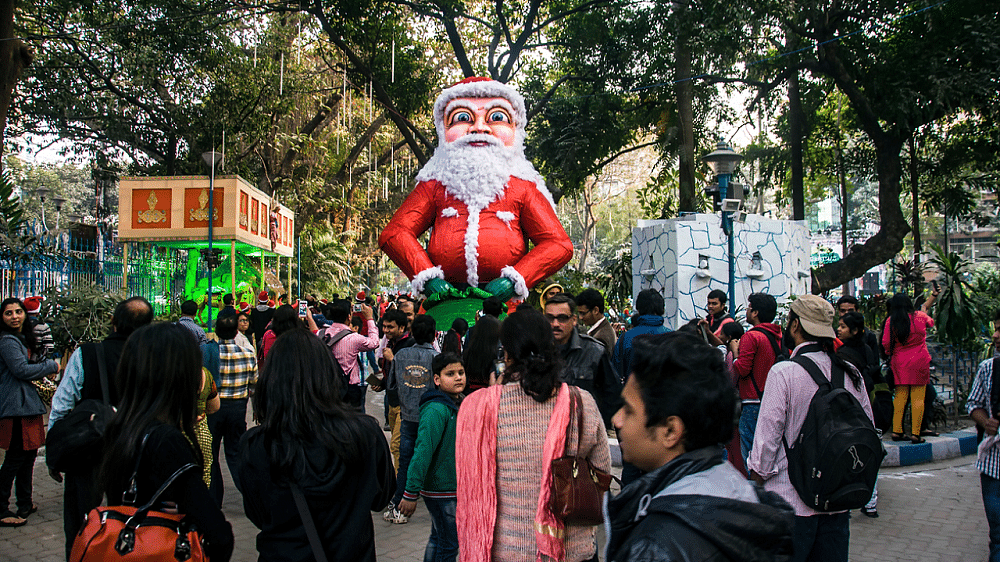
Christians make up a little over 2 per cent of India’s population. Many more of us celebrate Christmas. That still doesn’t place it alongside Diwali or Holi in terms of celebrants’ numbers. Celebrant enthusiasm is another matter. Children write to Santa. Stockings are hung. Come the day, gifts are unwrapped and carols play on loop. If we were better informed and less coy people, there would be mistletoe around too.
Businesses reinforce and harvest the season’s mood. Malls deck up. Special food menus reach inboxes. Clothes and shop windows get the red-white-green palette. And in telling evidence of the festival’s spill from expected quarters – diplomatic enclaves, swank, gated communities, and Christian homes and clusters - Christmas trees, lights, and treats appear in neighborhood markets and Santa masks and caps get hawked at traffic lights.
The long and short of it is that Christmas in India, though not quite mass, is popular and has charmed people like us. It wasn’t always this way. I suspect most of India’s Middle Class Gen-X discovered Christmas in the steps I did.
Textbook chapters on Jesus mentioned his birthday, Christmas, Burra Din, and the global occasion for commemorating his teachings it had become. Some of us saw the odd kandil go up in the neighborhood; Irene from ours used to have a large red cellophane one on the jamun tree in her courtyard. Luckier ones would’ve grown in neighborhoods well-knit enough for eats to be delivered and partaken. Missionary school-goers, I have heard it said, nay alleged, have a separate, more coerced-immersed experience. Well, it didn’t happen in our Jesuit-run school, and I have heard no different from any credible source.
The first intimation of the big deal Christmas came from Doordarshan. These were via short news clips of midnight masses and Christmas revelries across the world, but they struck and stuck as only tiny clips from those clip-starved times could. They confirmed what the textbooks said about the enduring and global relevance of Jesus’ message, but the chief takeaway from them was something else: that Christmas was fun and cosmopolitan. A trifle shallow, yes, reflecting fandom of the white and foreign, yes, but hey, not off the mark at all considering the season’s joyous, embracing spirit.
There were other reasons why the Christian-Christmas association with jollity and openness worked. Christian lads reportedly had permission to sip wine on Christmas. Grass being greener on the other side of the fence, this seemed a higher-order pleasure than our own licensed gulps of bhaang-laced thandais. Bollywood introduced us to jolly, well-meaning Johns and Tonys, seductive, gold-hearted Ritas and Suzys. Hollywood films, as and when they became accessible, would add to the allure, educating us on Christmas tradition and new ideas of cool and celebration. They would go on to tell us the best ways to spend - in all its relevant meanings - the holiday, and we obliged.
Millennials and subsequent arrivals have, predictably, taken a different and quicker route to find their Christmas. Cakes in bakers’ shelves, trees in drawing rooms, and Christmas melas haven’t been rarities for them, just parts of an expanding fixture set. They have laughed off Bollywood stereotypes, become less enamored of old, stylized Hollywood, and take cues about Christmas plans from Christmas releases and television shows about ordinary folk they connect with. Some have travelled and studied abroad, gotten to know things first-hand, and spread the light on return.
No matter how we’ve discovered Christmas and how we’ve come to celebrate it, the fun, cosmopolitan tag has stuck. Come to think of it, that makes the Indian Christmas more of a cultural than a religious occasion. This is not too different from the West. Less than half of America considers Christmas a religious festival as opposed to a cultural one, a 2017 Pew Survey revealed.
Shorn of its religious side, promising harmless fun and self-affirmations of modernity, Christmas has been easy for us to accept and enjoy. It all threatens to change.
Noise about ‘rice bag’ conversions has had its believers for a while now, and charges of cultural subversion, moral corruption, and covert evangelism by Christian forces in the name of Christmas and Valentine’s Day and under the auspices of missionary schools and hospitals have an increasing number of – and rather angry – takers now. Christian activists claim there has been an increase in attacks on the community in recent years. Christmas’ non-religious flavor, something that ‘protected’ it from bigot’s crosshairs, is no longer an adequate shield.
Anticipation will keep the more excitable ones among us awake on Christmas eve. Others will keep awake in anxiety. They shouldn’t have to. We all deserve a Merry Christmas.
(Manish Dubey is a policy analyst and writer)
Disclaimer: The views expressed above are the author’s own. They do not necessarily reflect the views of DH.